Go To: Chapter One |
Alfred Silvester – the Fakir of Oolu and his Family of Magic
Chapter Fourteen – Depression Years – Last of the Magical Silvesters - New Generations
Do not go gentle into that good night.
Old age should burn and rave at close of day;
Rage, rage against the dying of the light. – Dylan Thomas
… After a short rest he was organising trips out of Perth, visiting country towns. So much for home life. This was like the holiday breaks we had when I was young. Alf would decide that we all needed a break, and the four of us would head off for a week or so at a holiday resort. Almost immediately on arrival Alf would visit the local theatre managers and make arrangements for us to work during the intermissions. Some holidays … - Ida Harwood
Since this is not a work of fiction, there is no miracle waiting to happen. The life of Alf and Vera does not suddenly turn around to give a fairytale ending. What awaited the Silvesters in the Depression years, and until Alf’s retirement in the 1940s, was unrelenting hard work and struggle in the face of social upheaval and the decline of live theatre.
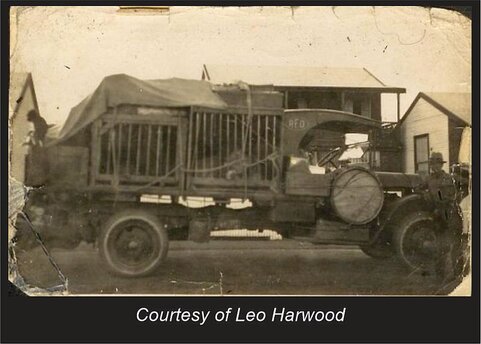
As the Great Depression started to take hold, Alf was performing in an 80-foot long canvas tent theatre as “Allan’s Bellringers and Entertainers” and was still working in Queensland where, by 1931 the company had again morphed, this time into the “Sill Family” (or sometimes the Sils family), which name would stay with them for most of the remaining years. The canvas theatre did good service until around 1933, but was eventually damaged beyond repair when it had to be brought down rapidly in a storm. Alf appeared on the bill with several other magical performers including the hypnotist Philip Hartley ‘The Great’ McEwen, and American card magic specialist DeForrest. Young Ida had finally thrown off the shackles of ‘Baby Ida’ and was now ‘Miss Ida’, her slack wire performances forming a major part of the show’s attraction. As a growing teenager she was closely guarded from the local male populace by an ever-vigilant Alf, and was starting to flex her own independence.
Ida’s recollections make clear that, gradually, the touring life was becoming more and more difficult. She spends numerous pages relating the trials of being on the road, now unable to afford even the humble boarding houses in which they previously stayed; not infrequently the company would bed down overnight in the same hall where they had performed. Even when a hotel room was available, the outdoor “dunnies” (toilets), the bed bugs, and the frequently inebriated fellow guests made for an uncomfortable existence.
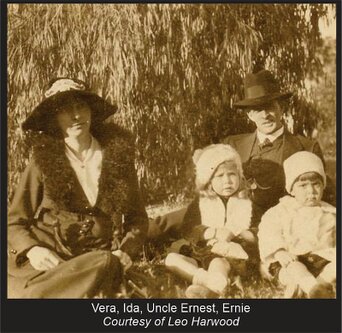
We worked the big towns and we worked the small towns, and as there were many more small towns than big ones, we had to keep on the move to eat. When I read about the problems being faced by our country towns I think that perhaps conditions haven't really changed very much over the years. Many small communities have disappeared as life became harder for them, leaving the remaining farmers isolated once again. In our days, as today, the onset of hard times meant little money in the community that could be spared on entertainment. Though living costs were very low compared to today everything is relative to your income, and we had to travel constantly to survive. In those days it would only cost, say, 2/- for breakfast, the same for bed, and another 2/- for dinner at night. Full board for 6/- (60c) per day. Not much if you had it, but getting it was the problem.
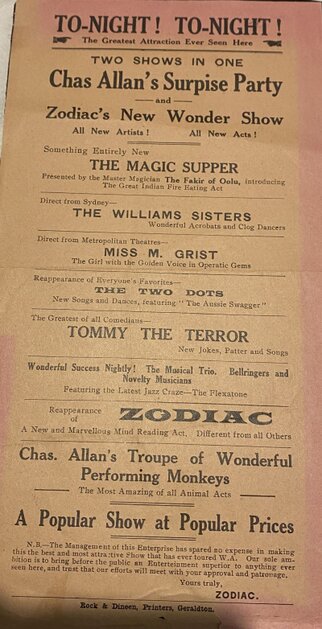
When we had money we stayed in hotels as you know. We lived well enough if we could afford it, but we worked darned hard to get it. Travelling for hours each day in bone shaking vehicles along the rough country tracks, working each night until midnight, or later, and then up with the birds next morning for an early start to the next town. Hotels weren't a luxury so much as a necessity for us. Travelling about like this, working different towns day after day, was known as working "one night stands" … To give you an idea of just how hard we worked during the show, I will give you an example of a typical program.
1. MAGIC ACT by ALF.
2. SONG AND DANCE by IDA & ERNIE.3.MAGIC by THE GREAT SILVESTER
4. SONGS by VERA.
5.VENTRILOQUIST ACT by ALF.
6.WIRE WALKING by IDA, THE LADY ON THE SILVER WIRE.
INTERVAL
7. MUSICAL ACT by ENSEMBLE.
8. MONKEY ACT by CHARLIE CHAPLIN & JENNIE.
9.SINGING by VERA, IDA AND ERNIE.
10.THE FINALE. MIND READING ACT, with ZODIAC LION, LIONESS AND LEOPARD
…Not only did we have the Depression and petrol rationing to contend with, the earlier introduction of talking pictures cut into our houses too. During hard times people would go to the "talkies" rather than come to our shows, and unfortunately for us they couldn't afford to attend both. When the opportunity presented itself Alf would arrange for us to put on shows in the theatres during the interval breaks, and in those early years our show would make up one half of the program.As if the talkies weren't bad enough, not so very long afterwards the new-fangled "wireless" started to become popular. The earlier crystal sets hadn't caused any problems, the reception they gave wasn't good enough to bother about really. Our troubles began when the shop owners started to display radios and put them where people could listen to the programs. Once entertainment was available in the home we had serious competition. The sight of would-be purchasers gathering around the magic boxes, much the same way they did around television sets all those years later, meant trouble for us. - Ida
Alf and Vera had their first child, Eric Ronald Silvester, in 1930, and with Vera frequently ill, care of the baby often fell to Ida. By 1934 Queensland had been played out, or the family wanted to make their way back home, and a move was made gradually back down into New South Wales where, for a long stay, they settled at Inverell but made side-trips to perform at surrounding towns. In mid-March, 1935 a second child, Shirley Silvester, was born at Inverell. Both children would be, to some degree, inducted into the family business (Baby Eric at the tender age of four as a singer – “he can’t speak too plainly, but oh boy, how he can sing”) but they do not appear to have been as fully involved as Ida and Ernie – and in any case they were still only youngsters by the time Alf decided to retire.
Ida, for the first time, plucked up the courage to tell Alf that she wanted to leave the show. “I wanted to get away from the non-stop travelling and camping-out, and the living and sleeping in halls. Both Ernie and I would have given anything to be able to lead young, normal lives. Well, didn't AIf hit the roof! He was lying down resting when I approached him, and he heard my news he leapt to his feet, grabbing hold of his walking stick as he did so, shouting to me, "If you ever talk of leaving the show again, I'll give you some of this"! He waved the stick at me and frightened me so much that I didn't dare raise the subject again until I had turned 21 and could legally do as I pleased. - Ida
There was a brief return into Queensland, but by 1936 the family had travelled back to Western Australia via South Australia, and in December the Sils Family appeared at the Luxor Theatre, Perth.
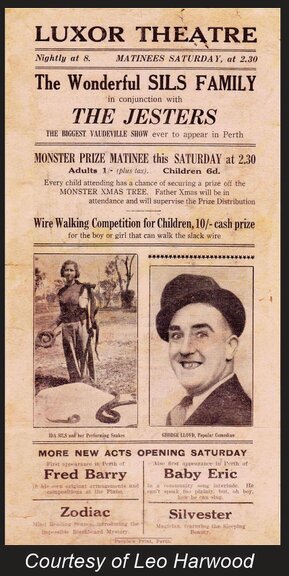
It must have been an enormous relief to be settled in (more or less) in one place. Ida had been through all manner of adventures and trials; she remembered a particular tour to Normanton, in the far north of Queensland on the fringe of the Gulf of Carpentaria:
This particular tour to Queensland was certainly a memorable one. We lost Cara, the monkeys demolished a fruit and vegetable shop and, later, died, and we lost the tent. We had some exciting times as well. On this particular trip we went as far north as Normanton. To get there in those days you had to catch a motor rail-car from the little town of Croydon. As far as I know this motor rail service is still operating, even after all these year although I think it is now mainly a tourist attraction. [It is … the Gulflander railway, promoted as ‘a journey from nowhere to nowhere’.] There was a road to Normanton but it was too rough to travel over if the journey wasn't absolutely necessary. Because of this we ladies travelled in style on the rail car, while the men drove the loaded trucks.
There were a number of rivers to be crossed along the way, and the progress of the trucks therefore depended on the condition of the crossings. The successful crossing of the rivers was governed to a large extent on the amount of rain that had fallen, or whether high tides were backing the rivers up. It really was wait-a-while country. As you know, the northern rivers of Australia have crocodiles living in them, and our men had to cross these rivers, crocodiles or not. At times the rail track ran close to the road, and on one occasion I can recall seeing the trucks crossing a river, with just a little way upstream from them, crocodiles cruising in the water. As you can imagine this scene did nothing for Mum's peace of mind. The rail car reached Normanton some time before the trucks, and we were all very relieved when the men finally arrived safely in town. At another time we were travelling by train and, because the flood waters were so high - it was also night time - one of the train's crew rode in front of the engine on a small hand-trolley testing the track's safety as he went. I can't recall that anything untoward happened that night, but I don't know what would have been done had the unfortunate man pumped his trolley into a great hole in the track.
These were very hard times for all Australians and we had to travel far and wide to earn our keep. No matter how hard it was for us it must have been many times worse for the men we often saw carrying their swags along the lonely bush tracks. To be forced to leave home and family and take to the track looking for work must have been a terrible thing for a man, and his family as well. We came across them from time to time, and always stopped and boiled the billy with them. We would share what food we could spare, but only rarely could we give them a ride. Our vehicles were jam-packed with our gear, there was hardly room enough for us as it was. - Ida
THE LUXOR THEATRE
Bounded by Stirling, Beaufort and James streets in Perth, the Luxor Theatre had undergone a series of developments and name changes since being opened as an open-air picture theatre (Shaftesbury Gardens 1911), gradually being enclosed until it became the Shaftesbury Theatre, then the Luxor (1925), and in later years the New Hollywood Theatre (1938-1941), described as the “Hollywood late Luxor” to 1944, Tivoli (1944) then Ice Palais skating rink and Canterbury Court. On arrival back in Perth, the Silvesters had performed as artists at the Luxor, then under the direction of popular dancer, Billy Heaton. By June 1937, Alf Silvester became the sole Lessee and Director of the Luxor, “Perth’s Recognised Home of Vaudeville” and began hiring variety acts to appear. The theatre, however, was not in good shape, with old wiring, no cross-aisles in the gallery, and shaky brickwork under the stage.
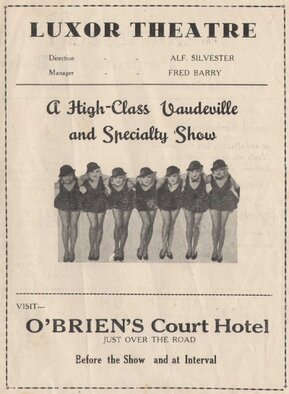
No matter how good Billy was at drumming up public interest it didn't stop him from going broke at the Luxor. After all the promotional stunts are over, you must have a good show to present to the public, but not even good shows guarantee financial success. For reasons that I never discovered, Alf took over the Luxor after Billy left. Whether it was his professional pride that drove him, his confidence that he could do better, I don't know. In hindsight it seems a silly thing to have done. The rent on the building cost him approximately 100 pounds a week which was not a lot of money for a theatre of its size, but, even with his experience and ability, Alf fared no better than Billy Heaton.
Despite having good entertainers presenting excellent routines, Alf went broke as well. During our time there we had the pleasure of working with some wonderful entertainers, top people in their fields. As well as local performers there were many from Sydney and the larger cities that Alf had brought to Perth. Promoters were always interested in good acts from other states, and Alf was no different. If heard of a good performer somewhere he would always be interested in getting him for his shows. Among the many that we worked with were The Paulasto Brothers, Fred and Ern. They were comedians who also did very good song and dance routines, the "soft shoe shuffle" type of act. Their act would often follow mine and as I left the stage I would often hand them a make-believe snake in a bag, which they would work into their comedy routines. One night I handed them a live snake instead of the fake one, just to see what they would do. Well, when they realised what they had they had to work with that night they performed, that's what they did. And all ad-lib, too. Neither of the brothers was the slightest bit impressed with me over the change, and although the audience thought it was hilarious they didn't forgive me for a long time afterwards. - Ida
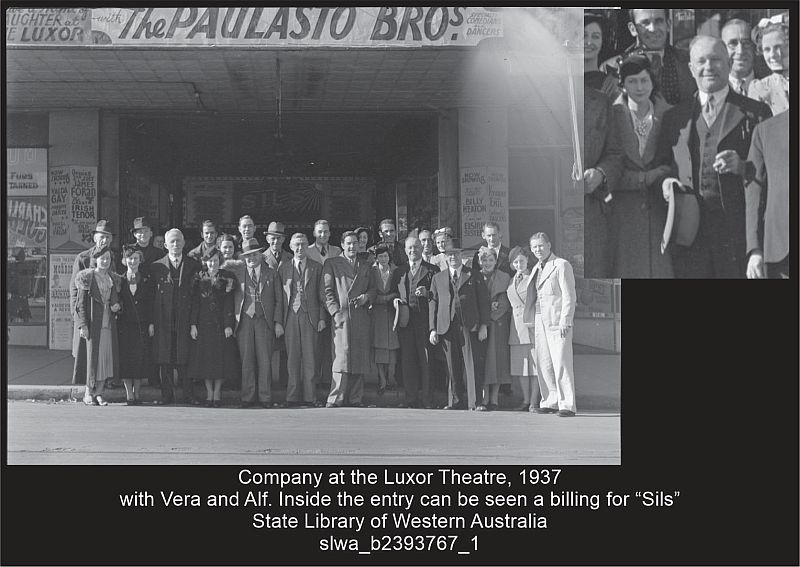
Internet histories of the Luxor Theatre repeat a standard phrase which can be traced to a comment made in 1939 by the then-lessee of the building:- “From about 1935 on—when the Shafto boys gave it up—the theatre degenerated into a low-class vaudeville theatre featuring strip-tease acts and leg shows.” (1) The evidence for this claim does not stack up. All the programmes, advertising and newspaper commentaries show that under Alf Silvester’s direction, the Luxor was a variety/vaudeville theatre presenting respectable acts, no strip tease noted, with a usual “beauty ballet” of dancers which was neither new nor risqué; they were simply attractive girls from Peggy and Rene Esler’s local dance school. What Alf was doing at the time was attempting to keep variety theatre afloat, in the face of the inevitable decline. The fact that his own family continued to provide the core of the show indicates that Alf was providing the usual mix of musical, novelty, singing, dancing and magic routines.
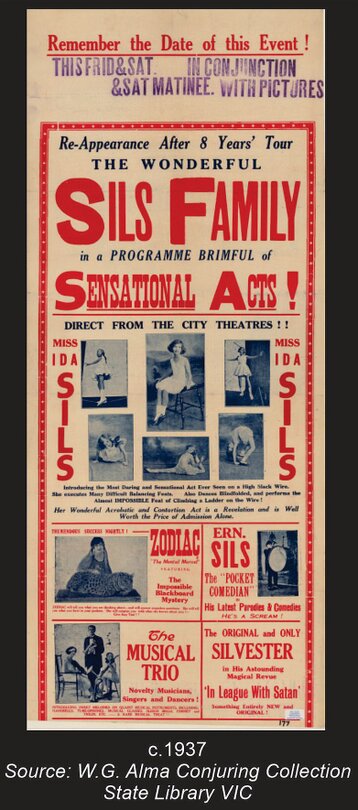
Being the director of the Luxor did not prevent Alf from roaming far and wide, whenever the opportunity to perform was available. He went out as far as Geraldton, Bunbury and Fremantle. In November, ‘Zodiac’s 20th Century Entertainers featuring the Wonderful Sils Family’ travelled down south to Bridgetown, Manjimup, Greenbushes, Pemberton, Nannup and Kirup in the course of a single week. Into 1938 the Sils Family was seen far and wide; as far north as Port Hedland, at least 1600 kilometres from Perth – Alf had the misfortune to be bitten by a snake he had captured at the ‘De Grey’ region. Patched up by a local doctor, he still managed to perform the same evening. (5)
In September 1938 the Geraldton Guardian had referred to Alf as “late lessee of the Luxor Theatre”; however on June 17, 1939 the Luxor rebranded as the “New Hollywood Theatre” with a production titled The Follies of 1939, and Alf was named as the sole director. It was a bold move for Alf to be presenting his ‘Night in Wonderland’ because across at His Majesty’s Theatre the grand illusionist Nicola (William Mozart Nicol) was presenting an array of fancy illusions such as the Indian Rope Trick, Million Dollar Mystery and the Iron Maiden. Nicola little knew that within months his entire show would lie at the bottom of Singapore harbour. (2)
I had found some freedom and enjoyment and wasn't about to give it up. It was on New Years Eve 1936/7 that the break came, and I had celebrated my 21st birthday just a short time before. I was going out for the New Years Eve celebrations, and as I was leaving Alf told me to make sure that I was home before midnight. I told him that I had no intention of coming home that early, I was going out to enjoy myself, to see the old year out and the new one in, and I would come home when I was ready. This led to a blazing row between us. Alf lost his temper and replied that while I was living under his roof I would do as he said. I told him that as I was now 21 years of age I would do as I pleased. And not only that, I was going to find myself another job and leave the show. I was going to live my own life. Alf went even further off the deep end at this, he laughed and shouted that I wouldn't be able to find a job - and keep it - without him behind me, telling me what to do. Well, I went out. And I stayed out until the New Year was well and truly "in". - Ida
For Alf Silvester, this must have been his warning that his career was reaching an end. In 1937 he was sixty-two years old, still determinedly working and travelling, but the almost inevitable departure of both his step-children from the show was the beginning of the end.
While I was working at the Ambassadors Ernie decided to leave the show as well. Looking back on it now it must have been a worrying time for Alf, although it didn't occur to me at the time. To replace us Alf introduced young Eric and Shirley to the show and kept our routines alive. Eric had a lovely singing voice for a youngster, and Shirley soon took over my wire routine. This period must have been the beginning of the end of the family show, Alf was by now an old man and though Mum was much younger than he was she was growing tired of the life-style. When Alf was on the road in the later years Mum was left to manage the Luxor, and the whole business must have been very worrying for them. - Ida

RETIREMENT AND FINAL DAYS
The old cliché is that ‘old performers never die, they simply fade away’. From 1940, Alf and Vera Silvester gently fade away from the newspapers and public records. Alf was then 65 years old. If, as Ida recalls, he continued to tour, nothing more has been located.
Having married in 1938 (see below), Ida was later living in Walpole on the far south-east coast. She relates:
We had an unexpected and enjoyable few days when Alf and Mum brought the show to Walpole. To create the atmosphere again I came out of retirement and worked with them for just the one show. I did enjoy performing my old routines again as I have said, and it was particularly good to see Mum again, although I found it hard to perform as well as I would have liked after such a long lay-off. Fortunately I wasn't bitten by the performing bug again, and had no wish to rejoin them after the experience.
And later:
Mum had retired some time before this and was delighted to mind the children for us. It was a good arrangement all round, we had somebody the children knew and loved, and Mum earned a little extra to add to her Aged Pension. There were no fortunes made by running Vaudeville shows, I can tell you. She and Alf had retired while we were at Walpole, and had sold off most of the instruments and equipment. I am pleased to say that some of it is still in the family. Ernie, Eric and I all have some original pieces which we still use regularly. Alf passed away not long after this, and as I have mentioned, Mum retired onto the pension. She was living quietly at her home in Barker Road and I think she was pleased to have eventually retired from the business. It must have become very tiring for them both as they grew older, and I don't think she ever missed that life in her later years.
Alfred William Silvester, in retirement, did not exactly go ‘gentle into that good night.’ He was noted providing a performance for the Childrens’ Hospital in 1944. In March 1945 (3) he advertised in the Melbourne ‘Age’ – “Wanted: Side Show attractions for Patriotic Entertainments – live snakes including carpet and diamond snakes; magical illusions, look and laugh mirrors &c. State particulars and price by air mail – Chas. Allan 175 Barker Road Subiaco, W.A.” In 1948 he advertised again as “Mr. Ree [mystery]” – “Several wonderful stage illusions, cheap, easy to work. Mr. Ree, 175 Barker-Rd Subiaco”
In February 1951, a small advertisement read “Ballet girls, novelty acts, singers, dancers, any stage attraction. Apply early. 175 Barker-Rd Subiaco.”
The Sydney Morning Herald reported the death of Alfred William Silvester, on February 13, 1956. He was 81 years old. There was no fanfare, no glowing tributes. Alf was buried at Karrakatta cemetery where, on her death some years later (February 21, 1970), he was joined by Vera Silvester.
With a last wave of the wand, all the magicians of the Silvester clan in Australia from 1874 had taken their final bow. There would be no more Fakirs of Oolu.
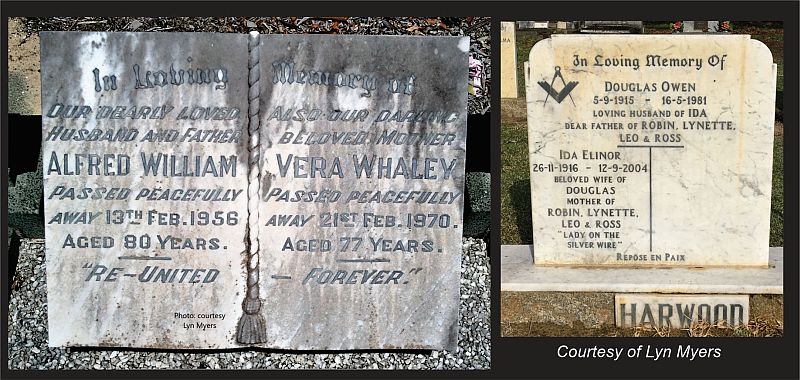
THE FAMILY STORY CONTINUES – FIVE GENERATIONS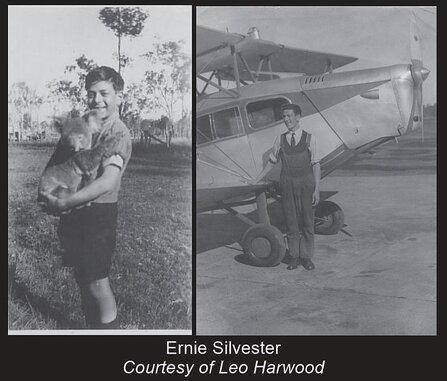

Although the last of the Silvester magicians were now departed, it would be an injustice to finish the history of the family there. The performing history of the fourth and fifth generations extends right up to the present day. (4)
Ernie Silvester retained the ‘Silvester’ family name. After departing the show before the start of World War II, he worked with an airline service flying between Perth and Rottnest Island, before signing up to the army in 1940 (10th Armed Regiment, Northam camp). Although the war drew to a close before he was posted away, he remained with the army for more than thirty years with the Royal Australian Army Ordnance Corps, and was posted to Nungarin. He was awarded a meritorious service medal in 1964, and finally retired in 1973. Ernie had married his first wife, Nell, in 1946, and on retirement he moved to North Queensland, continuing to play music with a local dance band and being known as a useful snake catcher, ‘the snake man of Tinaroo’. Ernie passed away in Queensland on July 22, 2005.
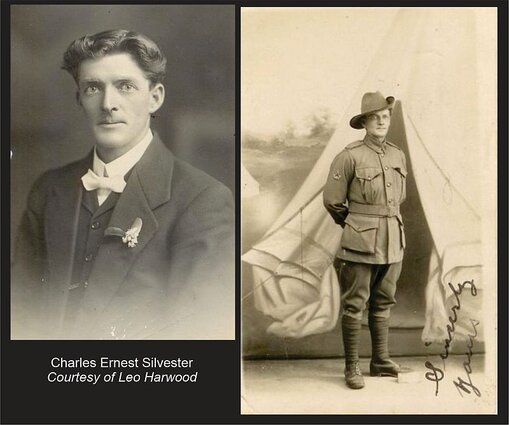
Charles Ernest Silvester (Vera’s brother) had served from 1916 in the Australian Imperial Force (Field Company Engineers). He divorced his first wife, May Alice, in 1919 before marrying Mary Elizabeth Grist (singer) in 1925 and became step-father to Melvin. He passed away on September 16, 1946 in Perth.
Alf and Vera’s son, Eric Silvester worked for the Post-Master General, married in 1954 and had three daughters. He died in 2010. Shirley Silvester was noted in 1951 as a teenage place-getter in a Perth bathing beauty competition. Her later history is elusive, presumably because of a marriage and name change.
All of the family, it seemed, had drifted out of the performing game. Surprisingly, it would be Ida who revived the theatrical side of the family. Before leaving the business, she had met a young musician, Douglas Harwood, who played harmonica and saxophone with Alf’s show. Over time the pair fell in love, and married on December 12, 1938. It was the recovery years of the Depression, and times were still tough. After living at a number of different addresses in Perth, they took up the opportunity of taking over a block of farmland which had been handed back to the Rural Bank and the government’s land settling scheme. Walpole, in the far south-west of Western Australia, today has a population of less than 500. For Ida, perhaps, it was an adventure, though a daunting one, away from the wearying life on the road.
Doug's family and mine couldn't have been more different if we had deliberately chosen them to be so. My life had been a wandering, almost hand-to-mouth affair, while Doug came from a solid, reliable family with a business background. His father was the manager of one of the big insurance companies in Perth [he was manager of Royal Exchange Assurance, W.A.], while mine ran a struggling Vaudeville show. Doug had attended Hale and Wesley Schools, while I had dropped in to hundreds of class rooms across the country. Well, at least I had the quantity of education if not the quality. At the time of our wedding Doug was working at Vetters’ garage, near the Royal Perth Hospital in Wellington Street, another old landmark that has disappeared with progress.
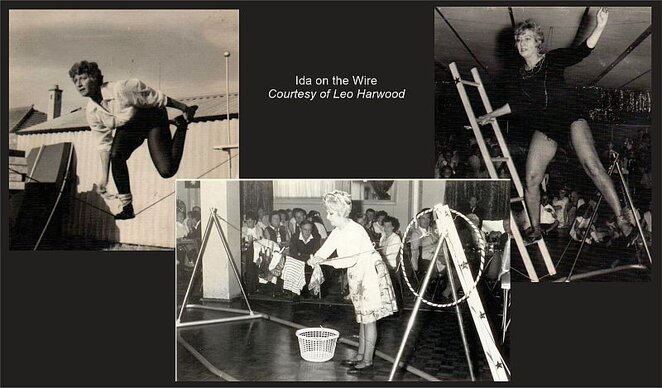
I don't think Doug's parents were initially all that impressed with the idea of their son marrying a Vaudeville girl, it certainly wouldn't have been the future they had hoped for him. As we grew more used each other we became good friends, and I soon discovered that I was marrying into a wonderful family who would become kind and loving in-laws. My parents were very fond of Doug too, and were pleased that we were marrying, so all in all we were two very lucky young people. Because of the way we had met, Doug and I had a standing joke in which he declared that I married him to get off the stage, while I would say that he married me to get on it. - Ida
The Walpole property was anything but grand; no electricity, the water came from a nearby creek, and the accommodation little more than a corrugated iron building. Ida was also pregnant with her first child, Robyn (born December 10, 1939). But Doug and Ida made the best of things, milking a small herd of cows early in the morning, worked at clearing and ploughing the land in preparation for crop planting, and coping with the isolation of the area. Eventually, however, Doug’s back was unable to stand the work involved, Robyn came down ill, and it was clear that the farm was not going to become viable. A move to Fremantle allowed Doug to work for the army for a couple of years, and another girl was born; she was Lynette Harwood.
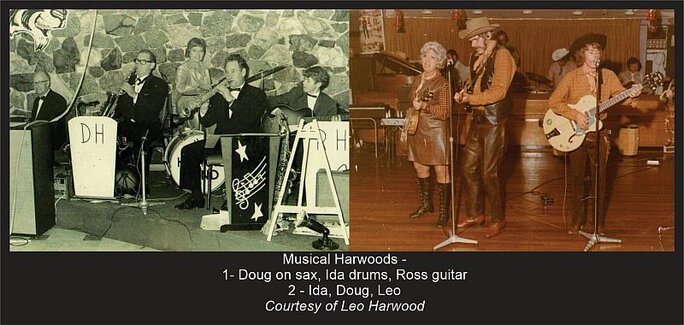
Finally the family returned to Perth, setting up in Barker Road, Subiaco opposite Vera Silvester’s home, and a business was commenced, “ABC Carriers”, quickly growing to a small fleet of furniture vans and a party-hire service supplying tables and dance floors. Almost without realising it, the party business led Ida and Doug to start polishing up their performing routines and start to take on engagements.
During those years we regularly played at dances and parties which not only gave us extra income, it allowed us the wonderful opportunity to entertain others. The Silvester showbusiness blood was still running strongly in my veins, and fortunately for us both, Doug had the same need to perform. Even today, after more than 70 years in show business, I get as much enjoyment from entertaining as I did all those years ago.
When we first met at the Luxor Doug was playing harmonica, saxophone and banjo-uke. He played them extremely well, and these instruments were to feature in our show business lives for many years. During the Depression years he had at times given lessons for these instruments - he was a very good, patient teacher - and after we married he taught me to play the banjo-uke and the harmonicas, which are still important to the shows I currently perform. Alf had taught me to play drums while I was still a child, so between the two of us we could give our audiences a good and varied program. This variety of instruments allowed us to accompany each other’s instrumental acts and singing, and perform solos pieces in our own right. The learning process wasn't all one way traffic either, and I introduced Doug to some good balancing routines which all added up to a darn good double act.
One of the balancing acts that Doug liked performing was to balance on a plank of wood which was itself balanced across a smallish round barrel - a small see-saw contraption in fact. After steadying himself on the plank he would stand and play the harmonica while gently maintaining his balance. This was an impressive act, and there would be many people around the country who remember watching his performances. As he became more experienced he began improving the act, ending up with layers of boards each separated by drinking glasses, with Doug standing on the top layer, modestly playing his harmonica. This was even more impressive, and never failed to draw enthusiastic applause from the audience. - Ida
The family entertainment group grew larger with the arrival of two sons; Leo and Ross. Now there was another family of variety artists, and Ida was kept busy with participation in all sorts of local activities at Subiaco, and having the enjoyment of watching their children grow in a pleasant suburban environment.
We certainly didn't sit around watching the grass grow in those days. Throughout our careers we always made time for charity work - that is, giving our time and effort for worthwhile causes. While I was young Alf had always been prepared to contribute to charity shows where ever we happened to be, he always helped out if he could. Not all entertainers liked to become involved in these efforts and would disappear from sight if they saw someone who even looked like they were after some help. I am pleased to be able to say that, with all his faults, Alf never did this.
Over the years I have performed in gaols and hospitals, nursing homes, at gala charity shows, Lodges, and fund raisers for political parties. After Doug and I were married we were holidaying in Victoria, and while over there joined up with a group called "The Blind Concert Party" who travelled the Victorian country districts raising funds for the Blind School in Melbourne. This was very good for us because it gave us the chance to visit parts of the State we would not have seen otherwise. It was a talented group of people who mixed together happily, although we did have a saying that the only "blind" person in our show was the pianist. The poor man had a drinking problem, like so many pianists I remembered from my youth, and would be well and truly topped up when each show started. - Ida
So Ida returned once more to the entertainment business, and if her travels were not as arduous as previously, they were certainly extensive. The Harwood children involved themselves with the show in many ways – Robin was a regular singer, Leo was a drummer, juggled, and balanced on the teeter board, while Ross (1950 - 2015) played guitar and went touring with his parents for over ten years. Lynette (Lyn) would become a versatile entertainer in her own right, and will be mentioned shortly.
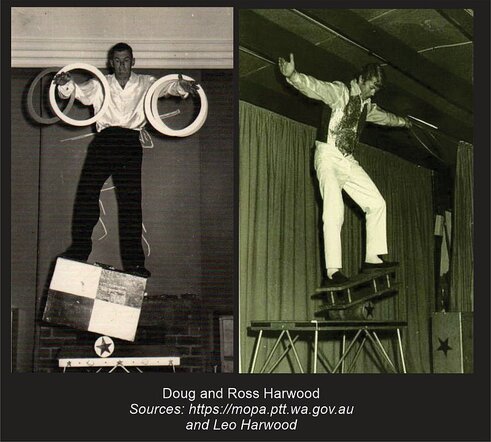
Doug’s new talent was the teeter board and juggling, along with his former musical skills on saxophone, banjo and harmonica (sometimes a giant harmonica). If there was a talent that Ida did not possess, it would be hard to find. She sang, played drums and banjo, still walked the slack wire, and had a plethora of entertaining musical novelties such as bellringing; one photograph shows her playing water-filled bottles with the use of a vacuum cleaner!
As the entertainment field gradually changed, so the Harwoods evolved to find new audiences. The onset of Australia television in 1956 was initially seen by variety artists as a new source of employment, and the Harwoods appeared numerous times in the 1960s, with their acts as known, and on Channel 7 with a ‘circus’ themed routine in which the performers created animal costumes to wear.
I later took part in another A.B.C. program, this time produced in the studio. In 1962 they presented a morning program called "Women's World", which was presented by Jim Millet. The particular production I was in was a feature titled "The Five Generations". This was a documentary featuring our combined show business families, The Silvesters and Harwoods - with Mum and myself and our children on camera. The five generations were Professor Silvester, Dr. Silvester, Alf Silvester and Mum, me, and my children. Being in the studio talking about show business and the differences "then and now", talking about our family and how unique it was to have such a long history in show business. – Ida
(Sadly, it is almost certain that this programme is no longer available, as the ABC would re-record over their video tapes)
In 1967 the Harwood trio (Ida, Doug and Ross) departed on a tour up to Carnarvon, leaving Leo to run the business. Ross learned the essentials of slack-wire walking and would develop a comic routine with Ida playing the role of a suburban housewife pegging her washing on the ‘line’ before walking the wire, and Ross interrupting in the character of a drunkard before staggering across the line, losing his coat and break-away trousers, and lying along the line for a drink and a sleep. It was a good tour, encouraging Doug to give up the truck business by 1968, and soon they were away again up the coast of Western Australia to Darwin (N.T.) and Alice springs, travelling in a caravan with a pair of Kombi vans. Ida wrote, “I was determined that this was going to be a comfortable trip - a far cry from my childhood travels - there was to be no sleeping in halls, and no pitching tents by the road-side either. That may have been so, but it did not save them from the trials of driving up north through driving rain and dry creeks that became raging torrents in the course of a single day. A broken axle put them out of action just outside Alice Springs.
Finishing up at “The Alice”, the choice was made to head home the long way, via North Queensland then through Mt. Isa and Tennant Creek. Back home, the entertainment world had again developed in a different direction. Now, licensed clubs were the place to work; work-related clubs, ethnic and religious clubs and of course sporting clubs, supported by the income from poker machines. The Harwoods were regulars at these venues, and more television appearances on the likes of Bobby Limb’s ‘Red Garter’ programme.
Finally, the world of cruise ships was made for the varied talents of the Harwoods. Travelling to Singapore, Hong Kong, Malaysia and any number of visits to Suva, it was a life which suited Ida and Doug, with the possible exception of a 1977 accident when the ‘Fairsky’ ran across a submerged object near Jakarta and tore a huge hole down the side. The captain had enough sense to run the ship aground on a sand bank and there were no casualties.
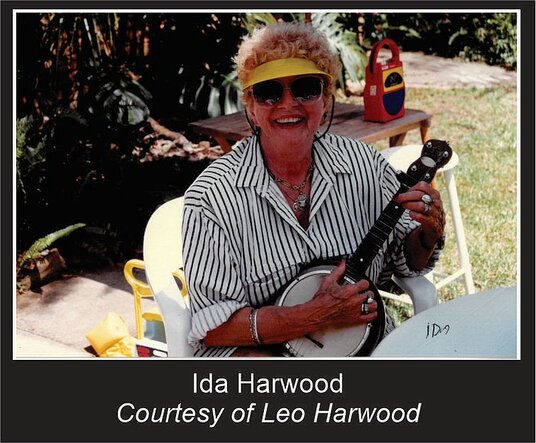
Before this, Ida became the first of the Silvester descendants to ‘return’ to the United Kingdom, travelling in 1972 aboard the Arcadia via the Panama Canal. A working tour of England, Ireland, Scandinavia and South Africa eventually brought them back to Australia.
It was in 1977 that Ida and Doug retired from seafaring, and drove home from Sydney across the Nullarbor Plain, to form a dance band which kept them active in Perth. In 1981, after 43 years of marriage, Ida was confronted with the trauma of Doug’s sudden death from heart failure. She wrote that, for her, the best therapy was to continue working. As the years passed, she had finally given away the wire walking, and gradually moved into retirement, if it could really be called that. Professional work gave way to retirement home entertaining and appearances for social groups, playing all her musical instruments, simple ventriloquial and puppetry routines, and joining in with daughter Lyn’s shows. In her seventies, Ida set about creating the invaluable memoir of her life, of which extracts have been given through these last two chapters.
Ida Harwood passed away on September 12, 2004 and is buried at Karrakatta Cemetery. In a tribute it was said that “she attended 580 schools in six states during her childhood... Her friends included the dispossessed aboriginal, the poor blighter swaggie on his last legs, the country parson with his home-sick wife, and the city urchin; the immigrant newly arrived was welcome at Ida’s table … when Ida entered the room the lights went on … [she] had no time for the dishonest … none could stand the heat when Ida entered the kitchen.”
LYN AND TONY MYERS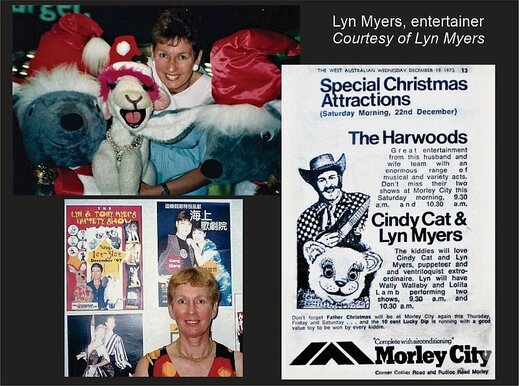

The entertainment history of the Silvester line was still not over, and as of the time of writing, continues. Ida’s daughter, Lynette (Lyn) grew to be a performer of scarcely less versatility than her mother. Her talents encompass puppetry and puppet making, ventriloquism, oil painting, cartoon sketches, keyboard and banjo playing, and singing. She became Lyn Myers after marrying Tony Myers, a jazz trumpet player whose father was sports broadcaster Lew Myers, and the grandson of ABC military band leader and champion trumpet player, Harry Shugg. Working professionally both as entertainers and for the I.B.M. company, Lyn and Tony have had a fifty-year performing career as the “Myers Variety Show”, entertaining across thousands of performances in Perth and its region, in shopping centres, many schools, country shows, for UNICEF and mining companies in the north of Western Australia, and nightclubs, restaurants and many cruise ships. With brother Leo, Lyn is the custodian of many family artefacts and is proud to share the story of the Silvesters in Australia; Leo compiles the ancestry of the Silvester and Harwood families.
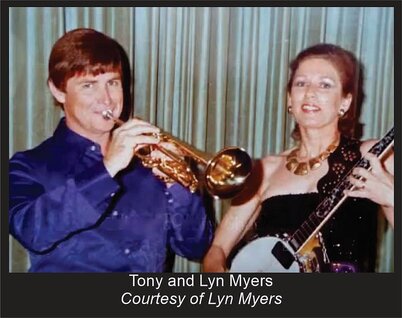
As with the entire Silvester line, Lyn and Tony have adapted to whatever new entertainment medium arises, and today they continue to produce brand new content for their YouTube channel, “Banjolyn1”, where several hundred videos can be found with the couple playing their instruments, singing jazz standards and classics including the songs of Fats Waller, Lyn displaying her many abilities – and by browsing, videos can be found of their cruise ship and jazz band performances; not to mention several videos of Doug and Ida Harwood performing in former years.

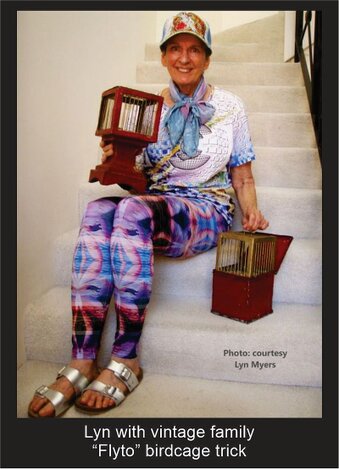
ALFRED SILVESTER’S FAMILY LEGACY
It is in the nature of things that history, unless re-told and passed along, tends to fade from memory. In the literature of magic, until now, Alfred Silvester’s life story has been summed up in little more than a few paragraphs, in connection with Pepper’s Ghost and the Suspended Lady. His history as a photographer in the 1850s is more complete, but ends as soon as he leaves the stereoscope business. It cannot be said that the name “Silvester” nowadays evokes a familiar response from lovers of magic or theatre in Australia. Certainly this is the first time that his entire life span, and that of his descendants, has been fully pieced together, and some sense made of the tangled family tree of magicians.
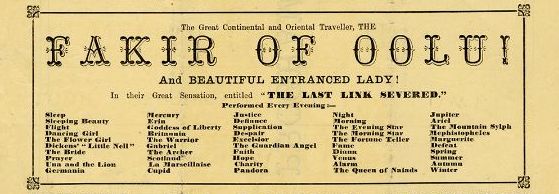
We do not know exactly why Dr. Silvester came to Australia. It was probably a speculative tour, hoping to pick up some good money and to use the country as a jumping-off point for visits to other countries; but, as is the case with a good many international performers, Silvester found something in this country which appealed to him enough to settle for life with his entire family. The magicians of Australia have been the beneficiaries of his inventive nature, the skill and mentoring of the Silvester sons (Alfred2 in particular), the introduction of major scripted stage illusions to our theatre, and the establishment of a lengthy and respected reputation under the name Silvester, or the ‘Fakir of Oolu’ which benefited all magicians. Some of the supporting acts who travelled with the Silvesters took away with them skills which would support them professionally for the rest of their lives. More than that, audiences in the largest city theatres and the smallest country halls were entertained and amazed for decades.
Evident across the entire story there is a sense of a passionate, almost obsessive, drive to get on the road and perform. The four male magicians who toured here, in New Zealand, and as far away as Singapore, never rested on their laurels. Each of their lives was a series of successes, failures, tragedies, adventures and determined resilience. No less so, their wives and daughters, who toured without respite, rebuilt their own lives against the disasters and calamities that befell them, spent interminable hours suspended in the air, and became performers of variety, song and dance with some of our best theatrical companies.
The Silvester family tree has now expanded in a thousand different directions. Perhaps somewhere within that line there awaits a new magician who will be able to trace his ancestry back to Alfred Silvester, the Fakir of Oolu.
REFERENCES FOR CHAPTER FOURTEEN
(1) The Daily News (Perth), November 21, 1949 page 6. Commentary by Bruce Carroll, lessee.
(2) William Mozart Nicol (1880 – 1946) soon faced disaster of his own, when in November 1939, on the outbreak of war, the SS Sirdhana struck a mine and sank, along with the vast majority of Nicola’s magnificent illusions.
(3) The Age (Melbourne), March 7, 1945 page 8, The West Australian March 6, 1948 page 25, and February 17, 1951 page 29.
(4) We have, however, discontinued the family tree (see Chapter 1) with the living descendants. There are of course many offshoots of the family, but not related to the “magic” focus of this story.
(5) The West Australian, September 22, 1938